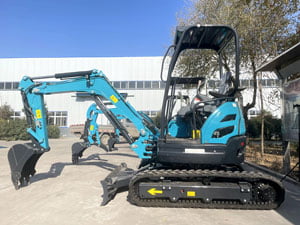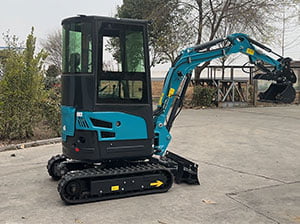Welkom op mijn blog!
Ik ben blij dat je er bent! Voordat we in de inhoud duiken, zou ik het leuk vinden als je me volgt op mijn social media platforms. Hier deel ik extra inzichten, ga ik de dialoog aan met een geweldige community en houd ik je op de hoogte van het laatste nieuws. Dit is hoe je op de hoogte kunt blijven:
Facebook: Connect met mij op Facebook
LinkedIn: Volg me op LinkedIn
▶️ YouTube: Kanaal trekkerfabrikant,Graafmachine fabrikanten kanaal
TikTok: Tractor Fabrikant,Graafmachine Fabrikant
Laten we nu samen aan deze reis beginnen! Ik hoop dat je de inhoud hier inzichtelijk, boeiend en vooral waardevol vindt. Laten we ontdekken, leren en groeien!
Inhoudsopgave
Inleiding
In today’s fast-paced construction, landscaping, and utility work environments, the ability to operate effectively in tight or confined areas is a major advantage. This is where the compacte minigraafmachine shines. Designed to offer maximum functionality in the smallest possible footprint, this equipment is a favorite among professionals seeking both performance and precision. Whether you’re working in urban settings, small yards, or greenhouses, a compact mini excavator can be your go-to tool.
This blog delves into the top eight advantages of using a compact mini excavator for tight spaces and why it’s a smart investment for businesses and individual contractors alike.
NO 1. Superior Maneuverability in Confined Areas
One of the most important benefits of a compacte minigraafmachine is its ability to move with ease in narrow or constrained environments. Traditional, larger machines often struggle with limited access points, but compact models are designed to squeeze into spaces where standard equipment simply cannot go. These machines offer a smaller footprint and advanced steering capabilities, making them the ideal tool for projects that require precision and flexibility in tight spots.
Compact mini excavators excel in a variety of settings, including:
- Residential backyard projects
- Indoor demolition tasks
- Navigating narrow alleyways and pathways
- Utility work between existing infrastructure
Their small size, combined with a tight turning radius and reduced tail swing, makes it possible to perform work efficiently without causing damage to nearby structures, walls, or landscaping. This added maneuverability translates into enhanced productivity and reduced risk of collateral damage on site.
NO 2. Cost-Effective Operation and Maintenance
While larger excavators may offer more power, they also come with significantly higher fuel, maintenance, and transport costs. Compacte minigraafmachines offer an affordable alternative without compromising on performance. These machines consume less fuel, require smaller trailers for transport, and generally have lower maintenance costs thanks to simpler, more robust designs and components.
Furthermore, many compact mini excavators are designed with easy-to-access service points, allowing operators to conduct routine maintenance without needing extensive downtime or costly service visits. These small, easy-to-maintain machines help to keep operational costs low and increase the overall profitability of the business.
The lower fuel consumption also contributes to reduced carbon footprints, making them a more sustainable choice compared to their larger counterparts.
NO 3. Versatility Across Multiple Applications


Despite their smaller size, compact mini excavators are impressively versatile. They can be outfitted with a Despite their smaller size, compacte minigraafmachines are impressively versatile. These machines can be equipped with a wide range of attachments that increase their functionality for different types of tasks. Some of the most common attachments include:
- Buckets of various sizes (for digging, scooping, or leveling)
- Augers for precise drilling tasks
- Hydraulic breakers for demolition jobs
- Thumbs for material handling
- Grapples for landscaping and forestry work
The ability to switch between attachments means that a single compact mini excavator can be used for multiple types of work, including trenching, digging, landscaping, lifting, and breaking tasks. Contractors who handle diverse jobs benefit from owning a single machine that can handle all these tasks, reducing the need for multiple specialized machines and minimizing equipment costs.
NO 4. Enhanced Fuel Efficiency and Environmental Impact
Fuel efficiency is becoming an increasingly important factor for both economic and environmental reasons. Compacte minigraafmachines tend to have smaller, more fuel-efficient engines that reduce emissions and overall fuel consumption. This makes them a greener choice compared to traditional larger excavators, which are often less efficient and contribute to higher carbon emissions.
In addition to environmental benefits, the lower fuel consumption also leads to significant cost savings over the lifetime of the machine. Many regions offer incentives for using cleaner machinery, such as rebates for participating in green-building projects or environmental compliance programs.
Moreover, the quieter operation of these machines is a bonus in noise-sensitive areas, such as schools, hospitals, or residential zones, where minimizing noise pollution is a priority.
NO 5. Easy Transportation and Setup
Transporting heavy machinery from site to site can be a logistical headache, but compact mini excavators are designed with portability in mind. Their lighter weight and smaller dimensions allow them to be easily transported using standard utility trailers, often eliminating the need for specialized transport services.
Setting up on a job site is just as efficient. The intuitive controls, easy-access panels, and minimal setup time allow operators to get the machine running in just a few minutes. This is particularly useful for quick jobs or projects that require frequent relocation. Whether you’re moving between different client sites or need to shift locations on a large project, a compact mini excavator can be quickly and easily repositioned.
Performance Comparison Table
Here is a comparison between compact mini excavators and traditional excavators in key performance areas:
| Functie | Compacte minigraafmachine | Traditional Excavator |
|---|---|---|
| Ideal for Tight Spaces | Ja | Geen |
| Fuel Consumption (avg per hour) | 2-4 liters | 6-10 liters |
| Transportable with Utility Trailer | Ja | Geen |
| Operator Learning Curve | Laag | Medium to High |
| Versatile Attachments Available | Ja | Ja |
| Noise Level (dB) | 70-80 | 90-100 |
NO 6. Reduced Jobsite Disruption
Compacte minigraafmachines create less disruption at job sites compared to larger machinery. Their smaller size means they cause less ground damage, disturb less of the surrounding landscaping, and minimize the need for extensive post-project cleanup. This is a particularly valuable feature when working in residential or urban areas where clients are concerned with maintaining the integrity of their property.
Additionally, compact models are less likely to damage underground utilities or tear up driveways, which is a common issue with bulkier machines. Being able to maneuver these machines precisely in confined spaces ensures that the surrounding infrastructure remains unharmed, which is a significant advantage for contractors working in built-up areas.
NO 7. Improved Operator Comfort and Accessibility


Operator comfort is essential for maintaining productivity, especially when working in tight spaces for extended periods. Many compacte minigraafmachines are designed with the operator’s comfort in mind. These machines feature ergonomic seats, intuitive control systems, air-conditioned cabins, and easy-to-read dashboards. All these features contribute to reducing operator fatigue and enhancing overall efficiency.
The user-friendly controls are especially helpful for operators who may be less experienced with heavy machinery. With minimal training, even new operators can become proficient quickly, further enhancing productivity.
NO 8. High Return on Investment
Investing in a compact mini excavator offers a high return on investment, especially for contractors who require equipment for multiple types of tasks. These machines are not only cost-effective in terms of fuel and maintenance, but their versatility means they can handle a wide range of applications, making them a valuable asset for any business.
Additionally, compact mini excavators often retain strong resale value, ensuring that the investment holds up over time. The consistent demand for used equipment in the market further enhances the long-term financial potential of these machines.
Conclusie
For anyone managing projects in confined or space-restricted environments, a compact mini excavator is not just a convenience—it’s a necessity. These machines offer unmatched versatility, easy operation, and cost-saving benefits while minimizing the environmental and physical footprint of the job.
Whether you’re a small business owner, a contractor, or a property developer, adding a compact mini excavator to your equipment lineup can greatly enhance your capabilities. Evaluate your current and future job requirements, and you’ll likely find that the benefits far outweigh the costs.
FAQ
What are the typical dimensions of a compacte minigraafmachine?
Most models are under 10 feet in length and about 4 feet in width, making them ideal for tight access jobs.
Kan compacte minigraafmachines zware taken aan?
While not suitable for large-scale industrial digging, many can handle demanding tasks such as trenching, lifting, and light demolition.
How long do compacte minigraafmachines usually last?
With proper maintenance, they can last between 8 to 15 years, depending on frequency and type of use.
Are these machines suitable for rental businesses?
Yes. Their ease of use and versatility make them popular in rental fleets, with high utilization and ROI.
Do compact mini excavators require special licenses to operate?
In many regions, they do not require a special license, but training is recommended for safe and efficient operation.




